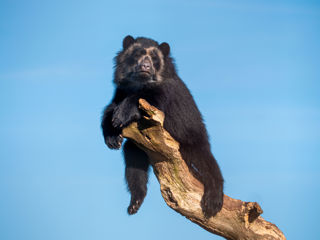
Capybara
Scientific name: Hydrochoerus hydrochaeris
Capybaras are the world’s largest rodents. The capybara belongs to the same family as the guinea pig and has many of the same features.
Capybaras have heavy, barrel-shaped bodies. Their partially webbed feet make them well-adapted for swimming. In addition, the capybara’s nose and eyes sit high on its face, making it easier for the capybara to see and breathe whilst it is swimming.
Capybaras are very sociable creatures and spend much of the day chattering back and forth. Besides hiding in the water, the capybara’s main form of defence is a warning bark, taken up by the entire group when one animal is threatened.
Male Capybaras have a scent gland on their nose (known as a morillo). It looks like a dark, sticky patch. Male capybaras use their morillo gland to mark their territory.

-
We live...
In the Viva South America enclosure, opposite the Lion enclosure.
-
Size Fact
Adult capybaras grow to 106-134cm.
-
Food Fact
Capybaras are herbivores. They mostly graze on grasses and aquatic plants.
-
Fun Fact
Capybaras love swimming and can remain submerged in the water for up to 5 minutes!

Adopt Me
You can support our conservation efforts and help with the costs of keeping rare and wonderful zoo animals by adopting a Capybara. Adopt a Capybara for yourself or as a gift.
You might also like...
-
![Meerkats]()
Meerkat Keeper Talk
Come along and learn about our mob of Meerkats from our experienced animal keepers.
Find out more
-
![Zoe And Falcon]()
Bird of Prey Flying Display
Watch our majestic birds of prey in our new Wings of Wonder flying display.
Find out more
-
![Andean Bear]()
Bear Keeper Talk
Learn about our Spectacled bears from our experts and find out what it is like to be a Spectacled bear keeper.
Find out more
-
![African Elephant - Shaka 2]()
Elephant Keeper Talk
Did you know Elephants are the largest land animals on Earth? Come and join our Elephant Keepers and learn about our bulls.
Find out more






